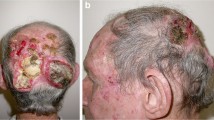Abstract
The few studies on the venous vascularization of the temporal area indicate a high variability among individuals. The preoperative knowledge of the venous vascularization of the temporal area is critical for microsurgical reconstruction, such as temporoparietal fascia free flap, and especially in understanding the anatomy of the veins for flap survival. Therefore, we conducted an anatomic study to confirm the classification of Legre et al. and a radiologic study to examine the venous network of the temporal area. We found three frequent patterns of the temporal venous network: (1) Type I (the most common), with a predominant temporal vein; (2) Type II, with a predominant posterior auricular vein; (3) Type III, when both veins were equally important. Because of this great variability, the use of a temporal flap for reconstruction of the head and neck should be restricted, and the examination of venous vascularization appears to be necessary before surgery. Here, we report a three-dimensional description of the venous temporal vascularization by computer tomography, which is particularly useful before temporoparietal flaps.







Similar content being viewed by others
References
Abul-Hassan HS, Von Drasek Ascher G, Acland RD (1986) Surgical anatomy and blood supply of the fascial layers of the temporal region. Plast Reconstr Surg 77(1):17–28
Brent BJ, Upton RD, Acland WW, Shaw FJ, Finseth C, Rodgers M, Pearl VR (1985) Experience with the temporoparietal fascial free flap. Plast Reconstr Surg 76(2):177–188
Brown WJ (1898) Extraordinary case of horse bite: the external ear completely bitten off and successfully replaced. Lancet 151:1533–1534
Burgasser G, Happak W, Gruber H, Freilinger G (2002) The temporalis: blood supply and innervation. Plast Reconstr Surg 109(6):1862–1869
Cesteleyn L, Helman J, King S, Van De Vyvere G (2002) Temporoparietal fascia flaps and superficial musculoaponeurotic system plication in parotid surgery reduces Frey’s syndrome. J Oral Maxillofac Surg 60:1284–1297
Cheung LK (1996) The vascular anatomy of the human temporalis muscle: implication in surgical splitting techniques. Int J Oral Maxillofac Surg 25(6):414–421
Diniz VM (1996) New use for the temporalis superficialis fascia in the facial contour: lip structure. Aesthet Plast Surg 20(6):519–526
Imanishi N, Nakajima H, Minabe T, Chang H, Aiso S (2002) Venous drainage architecture of the temporal and parietal regions: anatomy of the superficial temporal artery and vein. Plast Reconstr Surg 109(7):2197–2203
Legre R, Sandre J, Jallut Y, Vasse D, Bardot J, Ferdani M, Magalon G, Bureau H (1987) Utilisation du lambeau libre de fascia temporal superficiel: à propos de quatorze cas. Ann Chir Plast Esthet 32(4):333–343
Lopez R, Dekeister C, Ziad S, Paoli JR (2003) The temporal fasciocutaneous island flap for oncologic oral and facial reconstruction. J Oral Maxillofac Surg 61:1150–1155
Mmaks GH (1898) The restoration of a lower lid by a new method. Boston Med Surg J 139:385
Munnoch S (1999) Primary reconstruction of a degloved middle finger with a temporoparietal free flap. J Hand Surg (British Europ Vol) 24B(4):443–444
Nakajima H, Imanishi N, Minabe T (1995) The arterial anatomy of the temporal region and the vascular basis of various temporal flaps. Br J Plast Surg 48(7):439–450
Park C, Lew DH, Yoo WM (1999) An analysis of 123 temporoparietal fascial flaps: anatomic and clinical considerations in total auricular reconstruction. Plast Reconstr Surg 104(5):1295–1306
Rosse C, Gaddum-Rosse P (1997) Hollinshead’s textbook of anatomy, 5th edn. Lippincott-Raven, Philadelphia
Tellioglu AT, Tekdemir I, Endemli EA, Tuccar E, Ulusoy G (2000) Temporoparietal fascia: an anatomic and histologic reinvestigation with new potential clinical applications. Plast Reconstr Surg 105(1):40–45
Urken ML, Sullivan MJ, Chenet ML (1995) Temporoparietal fascia. In: Atlas of regional and free flaps for head and neck reconstruction, Raven Press, Philadelphia: Chapter 14
Williams PL (1995) Gray’s anatomy, 38th edn. Churchill Livingstone, London
Conflict of interest
The authors declare that they have no conflict of interest.
Author information
Authors and Affiliations
Corresponding author
Rights and permissions
About this article
Cite this article
Lopez, R., Benouaich, V., Chaput, B. et al. Description and variability of temporal venous vascularization: clinical relevance in temporoparietal free flap technique. Surg Radiol Anat 35, 831–836 (2013). https://doi.org/10.1007/s00276-013-1087-3
Received:
Accepted:
Published:
Issue Date:
DOI: https://doi.org/10.1007/s00276-013-1087-3




